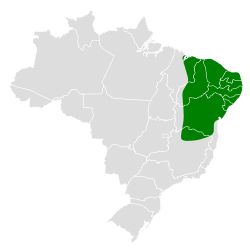| Red-cowled cardinal | |
|---|---|
 | |
| Scientific classification | |
| Kingdom: | Animalia |
| Phylum: | Chordata |
| Class: | Aves |
| Order: | Passeriformes |
| Family: | Thraupidae |
| Genus: | Paroaria |
| Species: | P. dominicana |
| Binomial name | |
| Paroaria dominicana | |
 | |
| Synonyms | |
Loxia dominicanaLinnaeus, 1758 | |
The red-cowled cardinal [2] (Paroaria dominicana) is a bird species in the tanager family (Thraupidae). It is not very closely related to the cardinals proper (Cardinalidae).
Contents
It is endemic to Brazil. It occurs in a wide range of dry to semi-humid open to semi-open habitats in north-eastern Brazil, especially the Caatinga region. It has been introduced (probably by means of escaped caged individuals) to Rio de Janeiro and São Paulo, being locally common even in urban areas. [3]

